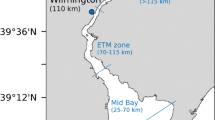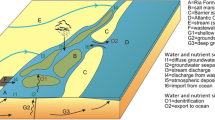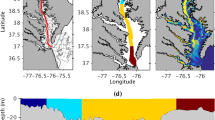Abstract
The effects of advection, dispersion, and biological processes on nitrogen and phytoplankton dynamics after a storm event in December 2002 are investigated in an estuary located on the northern New South Wales coast, Australia. Salinity observations for 16 d after the storm are used to estimate hydrodynamic transports for a one-dimensional box model. A biological model with nitrogen limited phytoplankton growth, mussel grazing, and a phytoplankton mortality term is forced by the calculated transports. The model captured important aspects of the temporal and spatial dynamics of the bloom. A quantitative analysis of hydrodynamic and biological processes shows that increased phytoplankton biomass due to elevated nitrogen loads after the storm was not primarily regulated by advection or dispersion in spite of an increase in river flow from <1 to 928×103 m3 d−1. Of the dissolved nitrogen that entered the surface layer of the estuary in the 16 d following the storm event, the model estimated that 28% was lost through exchange with the ocean or bottom layers, while 15% was removed by the grazing of just one mussel species,Xenostrobus securis, on phytoplankton, and 50% was lost through other biological phytoplankton loss processes.X. securis grazing remained an important loss process even when the estimated biological parameters in the model were varied by factors of ± 2. The intertidal mangrove pneumatophore habitat ofX. securis allows filtering of the upper water column from the lateral boundaries when the water column is vertically stratified, exerting top-down control on phytoplankton biomass.
Similar content being viewed by others
Literature Cited
Aldridge, D. W., B. S. Payne, andA. C. Miller. 1995. Oxygen consumption, nitrogenous excretion, and filtration rates ofDreissena polymorpha at acclimation temperatures between 20 and 32°C.Canadian Journal of Fisheries and Aquatic Sciences 52:1761–1767.
Allsop, D. andR. Kadluczka. 1999. Wallis Lake estuary tidal data collection March–June 1998. New South Wales Department of Public Works and Services and Manly Hydraulics Laboratory, MHL927, Manly Vale, Sydney, Australia.
Alpine, A. E. andJ. E. Cloern. 1992. Trophic interactions and direct physical effects control phytoplankton biomass and production in an estuary.Limnology and Oceanography 37:946–955.
Arnott, D. L. andM. J. Vanni. 1996. Nitrogen and phosphorus recycling by the zebra mussel (Dreissena polymorpha) in the western basin of Lake Erie.Canadian Journal of Fisheries and Aquatic Sciences 53:646–659.
Babarro, J. M. F., M. J. Fernández-Reiriz, andU. Labarta. 2000a. Feeding behaviour of seed musselMytilus galloprovincialis: Environmental parameters and seed origin.Journal of Shellfish Research 19:195–201.
Babarro, J. M. F., M. J. Fernández-Reiriz, andU. Labarta. 2000b. Metabolism of the musselMytilus galloprovincialis from two origins in the Ría de Arousa (north-west Spain).Journal of the Marine Biological Association of the United Kingdom 80:865–872.
Basu, B. K. andF. R. Pick. 1996. Factors regulating phytoplankton and zooplankton biomass in temperate rivers.Limnology and Oceanography 41:1572–1577.
Bayne, B. L., R. J. Thompson, andJ. Widdows. 1976. Physiology: I, p. 121–206.In B. L. Bayne (ed.), Marine Mussels: Their Ecology and Physiology. Cambridge University Press, Cambridge, Massachusetts.
Bridgeman, T. B., G. L. Fahnenstiel, G. A. Lang, andT. F. Nalepa. 1995. Zooplankton grazing during the zebra mussel (Dreissena polymorpha) colonization of Saginaw Bay, Lake Huron.Journal of Great Lakes Research 21:567–573.
Caraco, N. F., J. J. Cole, P. A. Raymond, D. L. Strayer, M. L. Pace, S. E. G. Findlay, andD. T. Fischer. 1997. Zebra mussel invasion in a large, turbid river: Phytoplankton response to increased grazing.Ecology 78:588–602.
Cloern, J. E. 1982. Does the benthos control phytoplankton biomass in south San Francisco Bay?Marine Ecology Progress Series 9:191–202.
Cloern, J. E. 2001. Our evolving conceptual model of the coastal eutrophication problem.Marine Ecology Progress Series 210:223–253.
Cloern, J. E., B. E. Cole, R. L. Wong, andA. E. Alpine. 1985. Temporal dynamics of estuarine phytoplankton: A case study of San Francisco Bay.Hydrobiologia 129:153–176.
Eyre, B. D. 2000. Regional evaluation of nutrient transformation and phytoplankton growth in nine river-dominated sub-tropical east Australian estuaries.Marine Ecology Progress Series 205:61–83.
Eyre, B. D. andD. Pont. 2003. Intra- and inter-annual variability in the different forms of diffuse nitrogen and phosphorous delivered to seven sub-tropical east Australian estuaries.Estuarine Coastal and Shelf Science 57:137–148.
Eyre, B. D. andC. Twigg. 1997. Nutrient behaviour during postflood recovery of the Richmond River estuary northern NSW, Australia.Estuarine Coastal and Shelf Science 44:311–326.
Fasham, M., H. Ducklow, andS. McKelvie. 1990. A nitrogen-based model of plankton dynamics in the oceanic mixed layer.Journal of Marine Research 48:591–639.
Ferguson, A., B. D. Eyre, andJ. Gay. 2004. Nutrient cycling in the sub-tropical Brunswick Estuary, Australia.Estuaries 27:1–17.
Figueiras, F. G., U. Labarta, andM. J. Fernández-Reiriz. 2002. Coastal upwelling, primary production and mussel growth in the Rías Baixas of Galicia.Hydrobiologia 484:121–131.
Fréchette, M. andE. Bourget. 1985. Energy flow between the pelagic and benthic zones: Factors controlling particulate organic matter available to an inter-tidal mussel bed.Canadian Journal of Fisheries and Aquatic Sciences 42:1158–1165.
Giles, J. 2002. The roles of salinity and predation on the size structure and distribution of the pygmy musselXenostrobus securis. Honours thesis, University of New South Wales Sydney, Australia.
Graham, J. M. 2000. Phytoplankton ecology, p. 547.In L. E. Graham and L. W. Wilcox (eds.), Algae, Prentice Hall, Upper Saddle River, New Jersey.
Hagy, J. D., L. P. Sanford, andW. R. Boynton. 2000. Estimation of net physical transport and hydraulic residence times for a coastal plain estuary using box models.Estuaries 23:328–340.
Jeffrey, S. W. andG. Humphrey. 1975. New spectrophotometric equations for determining chlorophylls a, b, c1, and c2 in higher plants, algae and natural phytoplankton.Biochemie und Physiologie der Pfanzen 167:191–194.
Hama, J. andN. Handa. 1994. Variability of the biomass, chemical composition and productivity of phytoplankton in Kinu-ura Bay, Japan during the rainy season.Estuarine Coastal and Shelf Science 39:497–509.
Heggie, D. T., G. W. Skyring, J. Orchardo, A. R. Longmore, G. J. Nicholson, andW. M. Berelson. 1999. Denitrification and denitrifying efficiencies in sediments of Port Phillip Bay: Direct determinations of biogenic N2 and N-metabolite fluxes with implications for water quality.Marine and Freshwater Research 50:589–596.
Horgan, M. J. andE. L. Mills. 1997. Clearance rates and filtering activity of zebra mussel (Dreissena polymorpha): Implications for freshwater lakes.Canadian Journal of Fisheries and Aquatic Sciences 54:249–255.
Jassby, A. D., T. M. Powell, andC. R. Goldman. 1990. Interannual fluctuations in primary production: Direct physical effects and the trophic cascade at Castle Lake, California.Limnology and Oceanography 35:1021–1038.
Koseff, J. R., J. K. Holen, S. G. Monismith, andJ. E. Cloern. 1993. Coupled effects of vertical mixing and benthic grazing on phytoplankton populations in shallow, turbid estuaries.Journal of Marine Research 51:843–868.
Kryger, J. andH. U. Riisgard. 1988. Filtration rate capacities in 6 species of European freshwater bivalves.Oecologia 77:34–38.
Lucas, L. V., J. E. Cloern, J. R. Koseff, S. G. Monismith, andJ. K. Thompson. 1998. Does the Sverdrup critical depth model explain bloom dynamics in estuaries?.Journal of Marine Research 56:375–415.
Lucas, L. V., J. R. Koseff, J. E. Cloern, S. G. Monismith, andJ. K. Thompson. 1999a. Processes governing phytoplankton blooms in estuaries. I: The local production-loss balance.Marine Ecology Progress Series 187:1–15.
Lucas, L. V., J. R. Koseff, S. G. Monismith, J. E. Cloern, andJ. K. Thompson. 1999b. Processes governing phytoplankton blooms in estuaries. II: The role of horizontal transport.Marine Ecology Progress Series 187:17–30.
Mallin, M. A., H. W. Paerl, J. Rudek, andP. W. Bates. 1993. Regulation of estuarine primary productivity by watershed rainfall and river flow.Marine Ecology Progress Series 93:199–203.
Officer, C. B. 1980. Box models revisited, p. 65–114.In P. Hamilton and K. B. Macdonald (eds.), Estuarine and Wetland Processes, with Emphasis on Modeling, Volume 11. Plenum Press, New York.
Redfield, A. C., B. H. Ketchum, andF. A. Richards. 1963. The influence of organisms on the composition of sea water, p. 26–79.In M. N. Hill (ed.), The Sea, Volume 2. Wiley Interscience, New York.
Robson, B. J. andD. P. Hamilton. 2003. Summer flow event induces a cyanobacterial bloom in a seasonal western Australian estuary.Marine and Freshwater Research 54:139–151.
Roditi, H. A., N. F. Caraco, J. J. Cole, andD. L. Strayer. 1996. Filtration of Hudson River water by the zebra mussel.Estuaries 19:824–832.
Roson, G., X. A. Alvarez-Salgado, andF. F. Perez. 1997. A nonstationary box model to determine residual fluxes in a partially mixed estuary, based on both thermohaline properties: Application to the Ria de Arousa (Spain).Estuarine Coastal and Shelf Science 44:249–262.
Sanders, R., C. Klein, andT. Jickells. 1997. Biogeochemical nutrient cycling in the upper Great Ouse Estuary, Norfolk, U.K.Estuarine Coastal and Shelf Science 44:543–555.
Scharler, U. M. andD. Baird. 2003. The influence of catchment management on salinity, nutrient stochiometry and phytoplankton biomass of Eastern Cape estuaries, South Africa.Estuarine Coastal and Shelf Science 56:735–748.
Smaal, A. C. andM. R. van Stralen. 1990. Average annual growth and condition of mussels as a function of food source.Hydrobiologia 195:179–188.
Smith, S. V. andM. J. Atkinson. 1983. Mass balance of carbon and phosphorus in Shark Bay, WA.Limnology and Oceanography 28:625–639.
Smith, S. V. andH. H. Veeh. 1989. Mass balance of biogeochemically active materials (C, N, P), in a hypersaline gulf.Estuarine Coastal and Shelf Science 29:195–215.
Steele, J. H. andC. W. Clark. 1998. Relationship between individual- and population-based plankton models.Journal of Plankton Research 20:1403–1415.
Wilson, B. R. 1968. Survival and reproduction of the musselXenostrobus securis (Lamarck) (Mollusca: Bivalvia: Mytilidae) in a western Australian estuary. Part I. Salinity tolerance.Journal of Natural History 2:307–328.
Wilson, B. R. 1969. Survival and reproduction of the musselXenostrobus securis (Lamarck) (Mollusca: Bivalvia: Mytilidae) in a western Australian estuary. Pt. II: Reproduction, growth and longevity.Journal of Natural History 3:93–120.
Sources of Unpublished Materials
Bureau of Meteorology. unpublished data. 700 Collins Street, Docklands, VIC 3008, Australia.
Standard Methods for the Examination of Water and Wastewater. unpublished data. 1992. American Public Health Association. 1015 Fifteenth Street, NW, Washington, D.C. 20005.
Department of Infrastructure, Planning and Natural Resources. unpublished data. 22–33 Bridge Street, Sydney NSW 2000, Australia.
Author information
Authors and Affiliations
Corresponding author
Rights and permissions
About this article
Cite this article
Moore, S.K., Baird, M.E. & Suthers, I.M. Relative effects of physical and biological processes on nutrient and phytoplankton dynamics in a shallow estuary after a storm event. Estuaries and Coasts: J ERF 29, 81–95 (2006). https://doi.org/10.1007/BF02784701
Received:
Revised:
Accepted:
Issue Date:
DOI: https://doi.org/10.1007/BF02784701




